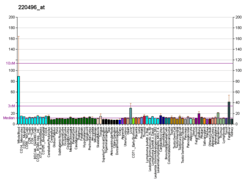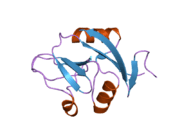CLEC1B
C-type lectin domain family 1 member B is a protein that in humans is encoded by the CLEC1B gene.[3][4][5]
Natural killer (NK) cells express multiple calcium-dependent (C-type) lectin-like receptors, such as CD94 (KLRD1; MIM 602894) and NKG2D (KLRC4; MIM 602893), that interact with major histocompatibility complex class I molecules and either inhibit or activate cytotoxicity and cytokine secretion. CLEC2 is a C-type lectin-like receptor expressed in myeloid cells and NK cells.[supplied by OMIM][5]
References
- ↑ "Human PubMed Reference:".
- ↑ "Mouse PubMed Reference:".
- ↑ Colonna M, Samaridis J, Angman L (Mar 2000). "Molecular characterization of two novel C-type lectin-like receptors, one of which is selectively expressed in human dendritic cells". Eur J Immunol. 30 (2): 697–704. PMID 10671229. doi:10.1002/1521-4141(200002)30:2<697::AID-IMMU697>3.0.CO;2-M.
- ↑ Sobanov Y, Bernreiter A, Derdak S, Mechtcheriakova D, Schweighofer B, Duchler M, Kalthoff F, Hofer E (Dec 2001). "A novel cluster of lectin-like receptor genes expressed in monocytic, dendritic and endothelial cells maps close to the NK receptor genes in the human NK gene complex". Eur J Immunol. 31 (12): 3493–503. PMID 11745369. doi:10.1002/1521-4141(200112)31:12<3493::AID-IMMU3493>3.0.CO;2-9.
- 1 2 "Entrez Gene: CLEC1B C-type lectin domain family 1, member B".
External links
Further reading
- Strausberg RL, Feingold EA, Grouse LH, et al. (2003). "Generation and initial analysis of more than 15,000 full-length human and mouse cDNA sequences". Proc. Natl. Acad. Sci. U.S.A. 99 (26): 16899–903. PMC 139241
 . PMID 12477932. doi:10.1073/pnas.242603899.
. PMID 12477932. doi:10.1073/pnas.242603899.
- Clark HF, Gurney AL, Abaya E, et al. (2003). "The secreted protein discovery initiative (SPDI), a large-scale effort to identify novel human secreted and transmembrane proteins: a bioinformatics assessment". Genome Res. 13 (10): 2265–70. PMC 403697
 . PMID 12975309. doi:10.1101/gr.1293003.
. PMID 12975309. doi:10.1101/gr.1293003.
- Gerhard DS, Wagner L, Feingold EA, et al. (2004). "The status, quality, and expansion of the NIH full-length cDNA project: the Mammalian Gene Collection (MGC)". Genome Res. 14 (10B): 2121–7. PMC 528928
 . PMID 15489334. doi:10.1101/gr.2596504.
. PMID 15489334. doi:10.1101/gr.2596504.
- Suzuki-Inoue K, Fuller GL, García A, et al. (2006). "A novel Syk-dependent mechanism of platelet activation by the C-type lectin receptor CLEC-2". Blood. 107 (2): 542–9. PMID 16174766. doi:10.1182/blood-2005-05-1994.
- Rual JF, Venkatesan K, Hao T, et al. (2005). "Towards a proteome-scale map of the human protein-protein interaction network". Nature. 437 (7062): 1173–8. PMID 16189514. doi:10.1038/nature04209.
- Watson AA, O'Callaghan CA (2006). "Crystallization and X-ray diffraction analysis of human CLEC-2". Acta Crystallogr. Sect. F Struct. Biol. Cryst. Commun. 61 (Pt 12): 1094–6. PMC 1978148
 . PMID 16511244. doi:10.1107/S1744309105037991.
. PMID 16511244. doi:10.1107/S1744309105037991.
- Scherer SE, Muzny DM, Buhay CJ, et al. (2006). "The finished DNA sequence of human chromosome 12". Nature. 440 (7082): 346–51. PMID 16541075. doi:10.1038/nature04569.
- Chaipan C, Soilleux EJ, Simpson P, et al. (2006). "DC-SIGN and CLEC-2 mediate human immunodeficiency virus type 1 capture by platelets". J. Virol. 80 (18): 8951–60. PMC 1563896
 . PMID 16940507. doi:10.1128/JVI.00136-06.
. PMID 16940507. doi:10.1128/JVI.00136-06.
- Watson AA, Brown J, Harlos K, et al. (2007). "The crystal structure and mutational binding analysis of the extracellular domain of the platelet-activating receptor CLEC-2". J. Biol. Chem. 282 (5): 3165–72. PMID 17132623. doi:10.1074/jbc.M610383200.
- Suzuki-Inoue K, Kato Y, Inoue O, et al. (2007). "Involvement of the snake toxin receptor CLEC-2, in podoplanin-mediated platelet activation, by cancer cells". J. Biol. Chem. 282 (36): 25993–6001. PMID 17616532. doi:10.1074/jbc.M702327200.
- Watson AA, Eble JA, O'Callaghan CA (2008). "Crystal structure of rhodocytin, a ligand for the platelet-activating receptor CLEC-2". Prot. Sci. 17 (9): 1611–6. PMC 2525532
 . PMID 18583525. doi:10.1110/ps.035568.108.
. PMID 18583525. doi:10.1110/ps.035568.108.
PDB gallery |
|---|
| 2c6u: CRYSTAL STRUCTURE OF HUMAN CLEC-2 (CLEC1B) |
|
|


 . PMID 12477932. doi:10.1073/pnas.242603899.
. PMID 12477932. doi:10.1073/pnas.242603899. . PMID 12975309. doi:10.1101/gr.1293003.
. PMID 12975309. doi:10.1101/gr.1293003. . PMID 15489334. doi:10.1101/gr.2596504.
. PMID 15489334. doi:10.1101/gr.2596504. . PMID 16511244. doi:10.1107/S1744309105037991.
. PMID 16511244. doi:10.1107/S1744309105037991. . PMID 16940507. doi:10.1128/JVI.00136-06.
. PMID 16940507. doi:10.1128/JVI.00136-06. . PMID 18583525. doi:10.1110/ps.035568.108.
. PMID 18583525. doi:10.1110/ps.035568.108.